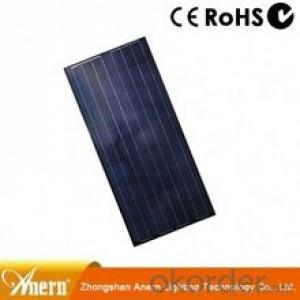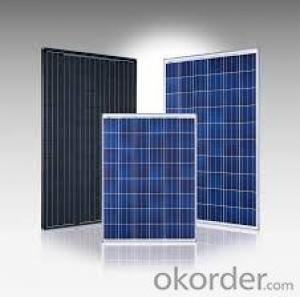Mono 156X156mm2 Solar Cells Made in China
- Loading Port:
- Shanghai
- Payment Terms:
- TT OR LC
- Min Order Qty:
- 6000 watt
- Supply Capability:
- 6000000 watt/month
OKorder Service Pledge
OKorder Financial Service
You Might Also Like
The operation of a photovoltaic (PV) cell requires 3 basic attributes:
The absorption of light, generating either electron-hole pairs or excitons.
The separation of charge carriers of opposite types.
The separate extraction of those carriers to an external circuit.
In contrast, a solar thermal collector supplies heat by absorbing sunlight, for the purpose of either direct heating or indirect electrical power generation from heat. A "photoelectrolytic cell" (photoelectrochemical cell), on the other hand, refers either to a type of photovoltaic cell (like that developed by Edmond Becquerel and modern dye-sensitized solar cells), or to a device that splits water directly into hydrogen and oxygen using only solar illumination.Characteristic of Mono 156X156MM2 Solar Cells
You are gaining energy independence - add battery backup power for even greater energy security
The cost of electricity is only going to rise – insure against that rising cost
Adaptive cells change their absorption/reflection characteristics depending to respond to environmental conditions. An adaptive material responds to the intensity and angle of incident light. At the part of the cell where the light is most intense, the cell surface changes from reflective to adaptive, allowing the light to penetrate the cell. The other parts of the cell remain reflective increasing the retention of the absorbed light within the cell.[67]
In 2014 a system that combined an adaptive surface with a glass substrate that redirect the absorbed to a light absorber on the edges of the sheet. The system also included an array of fixed lenses/mirrors to concentrate light onto the adaptive surface. As the day continues, the concentrated light moves along the surface of the cell. That surface switches from reflective to adaptive when the light is most concentrated and back to reflective after the light moves along
Mechanical data and design
Format | 156mm x 156mm±0.5mm |
Thickness | 210μm±40μm |
Front(-) | 1.5mm bus bar (silver),blue anti-reflection coating (silicon nitride) |
Back (+) | 2.5mm wide soldering pads (sliver) back surface field (aluminium) |
Temperature Coefficient of Cells
Voc. Temp.coef.%/K | -0.35% |
Isc. Temp.coef .%/K | +0.024%/K |
Pm.Temp.coef. %/K | -0.47%/K |
Electrical Characteristic
Effiency(%) | Pmpp(W) | Umpp(V) | Impp(A) | Uoc(V) | Isc(A) | FF(%) |
18.35 | 4.384 | 0.526 | 8.333 | 0.63 | 8.877 | 78.39% |
18.20 | 4.349 | 0.526 | 8.263 | 0.63 | 8.789 | 78.54% |
18.05 | 4.313 | 0.525 | 8.216 | 0.63 | 8.741 | 78.32% |
17.90 | 4.277 | 0.524 | 8.161 | 0.625 | 8.713 | 78.04% |
17.75 | 4.241 | 0.523 | 8.116 | 0.625 | 8.678 | 77.70% |
17.60 | 4.206 | 0.521 | 8.073 | 0.625 | 8.657 | 77.36% |
17.45 | 4.170 | 0.519 | 8.039 | 0.625 | 8.633 | 76.92% |
17.30 | 4.134 | 0.517 | 8.004 | 0.625 | 8.622 | 76.59% |
17.15 | 4.096 | 0.516 | 7.938 | 0.625 | 8.537 | 76.80% |
17.00 | 4.062 | 0.512 | 7.933 | 0.625 | 8.531 | 76.18% |
16.75 | 4.002 | 0.511 | 7.828 | 0.625 | 8.499 | 75.34% |
16.50 | 3.940 | 0.510 | 7.731 | 0.625 | 8.484 | 74.36% |




 FAQ
FAQ
Q: What price for each watt?
A: It depends on the quantity, delivery date and payment terms, generally Large Quantity and Low Price
Q: What is your size for each module? Can you tell me the Parameter of your module?
A: We have different series of panels in different output, both c-Si and a-Si. Please take the specification sheet for your reference.
Q: What is your size for each module? Can you tell me the Parameter of your module?
A: We have different series of panels in different output, both c-Si and a-Si. Please take the specification sheet for your reference.
- Q:Can solar cells be used in mining or extraction operations?
- Yes, solar cells can be used in mining or extraction operations. They can be employed to power various equipment and machinery used in these operations, such as lighting systems, ventilation systems, and pumps, reducing the reliance on fossil fuel-based energy sources. Additionally, solar cells can also be utilized to provide electricity to remote mining sites where grid connections are not feasible, thereby reducing the environmental impact and operational costs associated with these operations.
- Q:How do solar cells perform in areas with high levels of volcanic ash?
- Solar cells may not perform optimally in areas with high levels of volcanic ash. Volcanic ash can reduce the amount of sunlight reaching the solar cells, thereby decreasing their efficiency. Additionally, ash particles can settle on the surface of the solar panels, blocking sunlight and reducing their output further. Regular cleaning and maintenance may be required to ensure effective performance in such areas.
- Q:How do solar cells perform in extreme weather conditions?
- Solar cells generally perform well in extreme weather conditions, but their efficiency can be affected to some extent. In extremely hot conditions, solar cells may experience a decrease in efficiency due to increased thermal losses and a decrease in voltage output. Similarly, in extremely cold conditions, solar cells may also experience reduced efficiency due to decreased sunlight absorption and increased resistance. However, modern solar cell technologies are designed to withstand a wide range of weather conditions and have protective coatings to ensure their durability. Overall, while extreme weather conditions can have some impact on solar cell performance, they still remain a viable and reliable source of renewable energy.
- Q:Can solar cells be used for telecommunications infrastructure?
- Yes, solar cells can be used for telecommunications infrastructure. Solar cells convert sunlight into electricity, providing a renewable and sustainable source of power. By utilizing solar cells, telecommunication infrastructure such as cell towers, base stations, and remote communication devices can be powered independently, even in remote areas without access to the electrical grid. This helps to reduce reliance on fossil fuels, lower operational costs, and increase the reliability of telecommunications networks.
- Q:Can solar cells be used for electric vehicle charging?
- Yes, solar cells can be used for electric vehicle charging. Solar panels can convert sunlight into electricity, which can then be used to charge the batteries of electric vehicles. This allows for a sustainable and renewable source of energy for electric vehicle charging.
- Q:How does the photovoltaic cells work?
- Photovoltaic cells use the photovoltaic effect to convert sunlight directly into electric current and voltage.
- Q:How does the solar cell work properly?
- Silicon, as one of the most important semi-conductor material, plays a vital part in how to make the solar cells work.
- Q:What is the impact of leaf litter on solar cell performance?
- Leaf litter can have a negative impact on solar cell performance as it can block sunlight, reducing the amount of light reaching the cells and thus decreasing their efficiency. Additionally, leaf litter can also cause shading, leading to hotspots on the solar panels, which can further degrade their performance over time. Regular cleaning and maintenance of solar panels are necessary to mitigate the effects of leaf litter and optimize solar cell performance.
- Q:What is the lifespan of solar cells?
- The lifespan of solar cells can vary depending on various factors such as the type and quality of the cells, their usage and maintenance, and the overall conditions they are exposed to. However, on average, solar cells have a lifespan of around 25 to 30 years.
- Q:Can solar cells be used to power electric gates?
- Yes, solar cells can be used to power electric gates. Solar cells convert sunlight into electricity, which can be stored in batteries and used to power various devices, including electric gates. This allows for a sustainable and environmentally friendly solution to power electric gates without relying on traditional energy sources.
1. Manufacturer Overview |
|
|---|---|
| Location | |
| Year Established | |
| Annual Output Value | |
| Main Markets | |
| Company Certifications | |
2. Manufacturer Certificates |
|
|---|---|
| a) Certification Name | |
| Range | |
| Reference | |
| Validity Period | |
3. Manufacturer Capability |
|
|---|---|
| a)Trade Capacity | |
| Nearest Port | |
| Export Percentage | |
| No.of Employees in Trade Department | |
| Language Spoken: | |
| b)Factory Information | |
| Factory Size: | |
| No. of Production Lines | |
| Contract Manufacturing | |
| Product Price Range | |
Send your message to us
Mono 156X156mm2 Solar Cells Made in China
- Loading Port:
- Shanghai
- Payment Terms:
- TT OR LC
- Min Order Qty:
- 6000 watt
- Supply Capability:
- 6000000 watt/month
OKorder Service Pledge
OKorder Financial Service
Similar products
New products
Hot products
Hot Searches
Related keywords






























